Single-tailed varieties
Single tailed varieties have a single caudal fin and anal fin. They have long, streamlined bodies and are faster swimming than shorter egg-shaped goldfishes. They all come from common goldfish, but rare egg-shaped varieties like nymph goldfish are developed from egg-shaped goldfish. They have no telescopic eyes, celestial eyes, nor bubble eyes. They have no headgrowths like orandas, lionheads, and ranchus, narial bouquets like pompoms, or curled gills like curled-gill.
Long-bodied
- Common goldfish - It is the most common type of goldfish, hence the name. All varieties of goldfish are developed from this variety. It is the direct descendant of the wild Carassius auratus . It is also known as a feeder fish or feeder goldfish. Common goldfish come in a variety of colors including red, orange, blueish-grey, brown, yellow, white, and black. The most common variation is a shiny orange, with the second most common variation being a mix of white and red or orange and white. Although the color black is uncommon, yellow and black/white color pattern (trademarked as 'pandas') are rare.

- Comet goldfish - This is the most common goldfish variety in the United States. It is similar to the common goldfish, except for a long, deeply-forked tail, and the rest of its fins are long. It was developed in the United States from the common goldfish.

- Shubunkin - It is a hardy, single-tailed goldfish with nacreous scales and a pattern known as calico.
- London Shubunkins - It has a stout body and short, rounded finnage that is similar to the common goldfish.
- American Shubunkins - It has a slimmer body shape than the London Shubunkin with deeply forked, pointed tail fins and longer finnage all around. Its appearance is similar to the comet goldfish.
- Bristol Shubunkins - It is a slim-bodied goldfish with well-developed finnage, possessing a tail that is large, moderately forked, and rounded at the end. It has a large heart-shaped tail.

Egg-shaped bodied
- Nymph goldfish - It is similar to the fantail, except they have a single caudal fin and anal fin. Considered a byproduct of the breeding process due to recessive genes handed down from fantail or veiltail parents.
- Tamasaba goldfish (or Sabao goldfish) - It is similar to the ryukin, except they have a single caudal fin and anal fin. A rare type of fish mutated from the ryukins. It is developed from the ryukin.

Shubunkin are a hardy, single-tailed goldfish with nacreous scales and a pattern known as calico. They are of Japanese origin.

Calico goldfish are goldfish of any breed that have a type of scale that is intermediate between the metallic type of scales and the transparent type. These scales have a slight sheen that produces a pearly appearance. The name "calico goldfish" came about because the first fish that were introduced with this type of scales had a mottled calico pattern with several colours.

The Bubble Eye is a small variety of fancy goldfish with upward-pointing eyes that are accompanied by two large fluid-filled sacs. It is a dorsal-less fish – good specimens will have a clean back and eye bubbles that match in color and size. Their bubbles are quite delicate, so the fish should be kept separately from boisterous types, as well as sharp tank decor. Although the bubbles will regrow if punctured, an injury could leave the fish prone to infections. The bubbles can disadvantage the fish as it is not a strong swimmer, with a seemingly low bobbing head at times; bubbles are infamous for being sucked into filters and siphons in an aquarium.

The telescope, telescope goldfish or telescope eye is a goldfish characterised by its protruding eyes. It was first developed in the early 1700s in China, where the trait was referred to as dragon eyes.

The Ryūkin (琉金) is a short deep-bodied fancy goldfish with a characteristic hump in the shoulder region.

An oranda is a breed of goldfish characterized by a prominent bubble-like "hood" on the head. The headgrowth or hood may be a prominent growth on the top of the head or may encase the entire face except the mouth.

The Fantail is a goldfish that possesses an egg-shaped body, a high dorsal fin, a long quadruple caudal fin, and no shoulder hump. It is similar to the Ryukin, and is relatively common in western countries. The Fantail Goldfish is the base for many fancy goldfish species.

The lionhead is a hooded variety of fancy goldfish. This fish is the precursor to the ranchu.
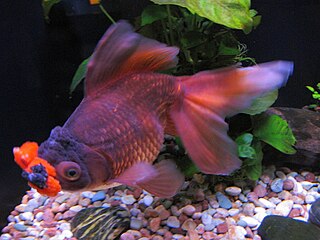
Pompom or hana fusa are a type of fancy goldfish that have bundles of loose fleshy outgrowths between the nostrils, on each side of the head.

The term coldwater fish can have different meanings in different contexts.

The Ranchū is a hooded variety of goldfish native to Japan, which lacks a dorsal fin. It is referred to as the "king of goldfish" by the Japanese. Maruko more commonly refers to the egg-fish goldfish.
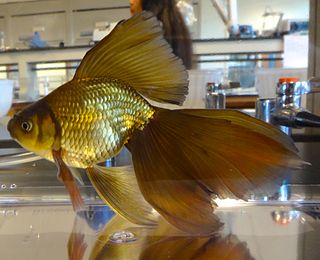
The veiltail is a type of goldfish known for its extra-long, flowing double tail and high sail-like dorsal fin.
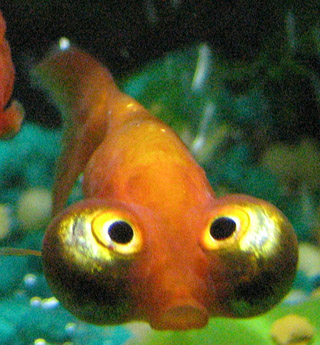
The celestial eye goldfish or Choutengan is a double-tailed breed of fancy goldfish that possesses a distinctive pair of telescope eyes, in which the eyeballs are turned vertically and the pupils appear to be gazing skyward.
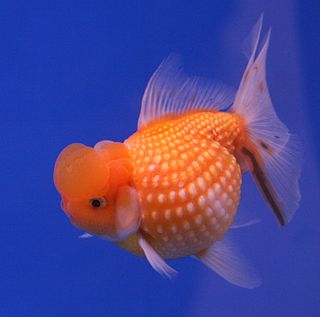
The Pearlscale or Chinshurin (珍珠鱗) in Japanese is a spherical-bodied fancy goldfish with doubled finnage similar to the fantail.
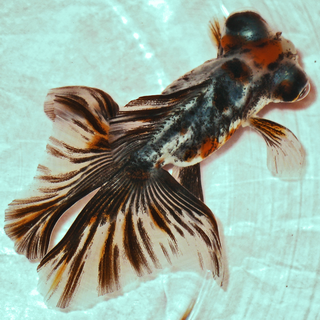
The Butterfly telescope goldfish is a variant of telescope goldfish that is distinguished by the butterfly-shaped caudal fins when viewed from above. It is a variety that has only recently been deemed a major lineage by a few published works. The tail conformation is commonly bred into the telescope eye goldfish, the term "butterfly tail" is just short for the many names this variety has such as Butterfly Tail Demekin, Butterfly Tail Black Moor and Top view Telescope (TVT), and many other goldfish varieties.
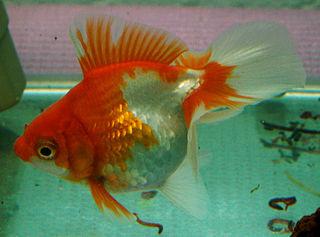
The Tosakin (土佐金) or curly fantail goldfish is a distinctive breed of goldfish with a large tail fin that spreads out horizontally behind the fish. Though technically a divided tail, the two halves are attached at the center, forming a single fin.

The Curled-gill or Reversed-gill goldfish is another uncommon variety of fancy goldfish that has been developed by specialist enthusiasts. It owes its name from the out-turned appearance of its gill covers. This fish resembles a Ryukin. For the appearance of this goldfish, it has a fantail-shaped body with long finnage all round as well as a deeply forked tail; the color is typically metallic orange.

The goldfish is a freshwater fish in the family Cyprinidae of order Cypriniformes. It is commonly kept as a pet in indoor aquariums, and is one of the most popular aquarium fish. Goldfish released into the wild have become an invasive pest in parts of North America and Australia.
The Wakin is an intermediate twin tailed goldfish variety that has been originated from Japan. It is believed the wakin gave rise to fancy twin-tailed goldfish, including the ryūkin, ranchū, oranda, fantail pearlscale, and many more twin-tailed goldfish. It is also the second oldest variety, developed from the common goldfish.

The jikin (地金), also known as the peacock tail goldfish, is a breed of wakin-like goldfish developed in Japan.
This page is based on this
Wikipedia article Text is available under the
CC BY-SA 4.0 license; additional terms may apply.
Images, videos and audio are available under their respective licenses.










































